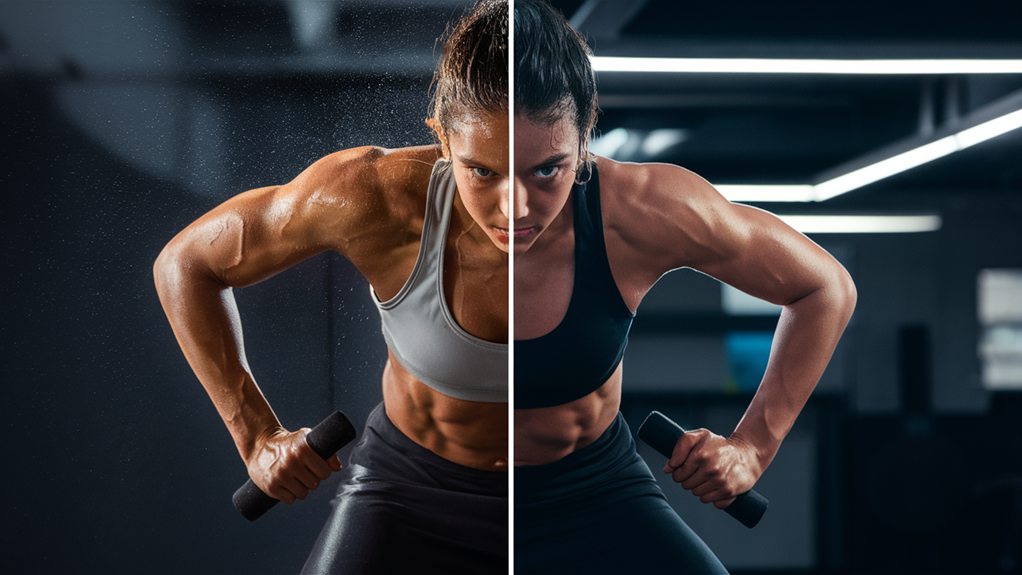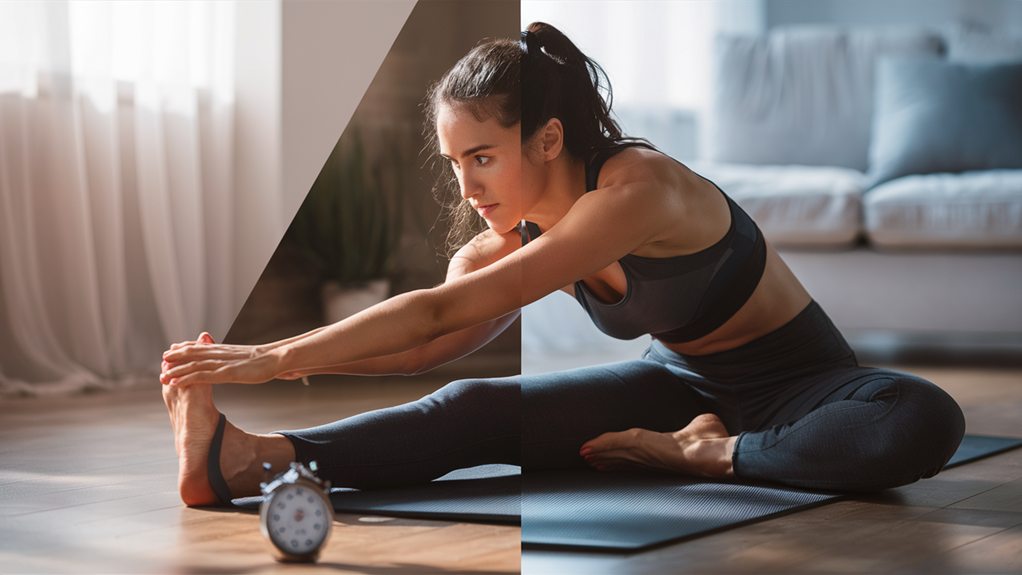HIIT workouts aren't just about sweating buckets or pushing yourself to exhaustion. While you'll alternate between intense bursts of exercise and brief recovery periods, success depends on proper form and heart rate management, not just how much you perspire. You don't need to be an athlete to start, as you can modify exercises to match your fitness level. HIIT can help maintain muscle mass when combined with good nutrition, and it's not exclusively a fat-burning workout. Remember to give your body adequate recovery time between sessions, typically 48-72 hours. Understanding these facts will help you make the most of this efficient training method.
What Is HIIT Training

Through intense bursts of exercise followed by brief recovery periods, HIIT (High-Intensity Interval Training) maximizes your workout efficiency in a fraction of the time compared to steady-state cardio. HIIT is known for its ability to burn calories quickly while also improving cardiovascular fitness and endurance, making it a highly effective training method for many individuals its principles and benefits.
When you're doing HIIT training, you'll push yourself to your limits during short, intense intervals, typically lasting 20 to 60 seconds, followed by brief rest periods or lower-intensity activities.
Understanding what's HIIT training helps separate myths vs facts about this popular workout method. You'll find that HIIT can include various exercises, from sprinting and jumping jacks to burpees and mountain climbers. The key is maintaining an intensity level that reaches about 80-95% of your maximum heart rate during the work intervals.
Debunking HIIT misconceptions starts with recognizing that these workouts don't need to last long – most effective sessions run between 10-30 minutes. Your recovery periods are equally important, allowing your body to prepare for the next intense burst while maintaining an elevated heart rate.
The beauty of HIIT lies in its versatility, as you can adapt it to your fitness level and modify exercises to suit your needs.
More Sweat Equals Better Results
A common misconception about HIIT training suggests that the more you sweat, the better your workout results will be. In fact, this is one of the most common HIIT myths that needs debunking, as sweating is simply your body's natural cooling mechanism, not a direct indicator of calories burned or workout effectiveness.
While HIIT can substantially contribute to the role of cardio in weight loss, the amount you sweat doesn't directly correlate with the effectiveness of your workout.
The truth about HIIT is that your body's sweat response depends on several factors that aren't necessarily related to workout intensity. You'll notice different sweat levels based on:
- The temperature and humidity of your workout environment
- Your individual genetics and natural sweat response
- Your current hydration levels and overall fitness
- The type of clothing you're wearing during exercise
While it's normal to sweat during HIIT workouts, you shouldn't use sweat as your primary measure of success. Instead, focus on maintaining proper form, following prescribed work-to-rest ratios, and monitoring your heart rate recovery between intervals.
You might've an incredibly effective HIIT session with minimal sweating on a cool day, or sweat buckets without getting ideal results in a hot, humid environment.
HIIT Burns Only Fat

Over the years, many fitness enthusiasts have embraced the misconception that HIIT workouts exclusively target fat cells while sparing muscle tissue. This simply isn't true, as your body doesn't selectively choose what energy source to use during high-intensity exercise.
In fact, the power of cardio and strength training highlights how both can complement each other for ideal weight loss results.
When you're performing HIIT workouts, your body actually taps into multiple energy systems and fuel sources. During the intense bursts of activity, you'll primarily use carbohydrates stored in your muscles (glycogen), while your body shifts to using more fat during the recovery periods.
Your body's also breaking down some protein from your muscles, especially if you're not consuming adequate nutrition to support your workouts.
To maximize your results and protect your muscle tissue, you'll want to combine HIIT with proper nutrition and strength training. Make sure you're eating enough protein, complex carbohydrates, and healthy fats to fuel your workouts.
You can even enhance your body's fat-burning potential by including resistance exercises in your HIIT routine, which helps preserve and build lean muscle while still getting those cardiovascular benefits you're looking for.
Training Level Requirements
Many beginners mistakenly believe they need to be fitness experts before trying HIIT, but that's not entirely accurate. While it's true that HIIT workouts can be intense, you can modify them to match your current fitness level and gradually build up your endurance. It's important to focus on proper form and gradually increase your intensity, which is vital for avoiding injuries and improving your overall fitness beginner-friendly HIIT workouts.
Before starting HIIT, you'll want to guarantee you have these basic foundations in place:
- The ability to perform basic exercises with proper form, such as squats, lunges, and push-ups.
- A baseline cardiovascular fitness level where you can exercise continuously for at least 20 minutes.
- Good body awareness and the ability to recognize when you need to slow down or take a break.
- Basic understanding of proper breathing techniques during exercise.
You don't need to be an athlete to start HIIT, but you should be comfortable with regular exercise. If you're completely new to fitness, start with steady-state cardio and basic strength training for a few weeks.
Once you've built some endurance, you can begin incorporating HIIT elements into your routine, starting with shorter intervals and longer rest periods. Remember, it's better to start slowly and progress safely than to risk injury by pushing too hard too soon.
Impact on Muscle Mass

Building from foundational fitness into more intense training brings us to a common question about HIIT: its effects on muscle mass. You'll be glad to know that HIIT can actually help you maintain and even build muscle, especially when you're combining it with proper nutrition and recovery periods.
Incorporating strength training into your routine is essential for enhancing muscle growth and improving bone density, making it a significant component of overall fitness the benefits of strength training.
When you're performing HIIT workouts, your body releases growth hormones and testosterone, which are important for muscle development. During the high-intensity intervals, you're creating tiny tears in your muscle fibers, and as they repair, they'll grow back stronger.
You'll find that bodyweight HIIT exercises, like push-ups and squats, can be particularly effective for muscle maintenance.
However, if building significant muscle mass is your primary goal, you'll want to combine HIIT with traditional strength training. The key is finding the right balance, as too much HIIT can interfere with muscle growth if you're not giving your body enough time to recover.
You'll get the best results by doing 2-3 HIIT sessions per week, while dedicating other workout days to focused resistance training.
Joint Health and Safety
Joint wellness deserves special attention when it comes to HIIT workouts, as the high-impact nature of these exercises can affect your body's movement systems. Many individuals have found success in transforming their health through consistent cardio exercise, highlighting the importance of maintaining joint integrity during these workouts personal success stories.
You'll want to prioritize proper form and technique to protect your joints, especially during exercises that involve jumping or quick directional changes.
To maintain joint health while doing HIIT, you'll need to focus on these essential aspects:
- Always perform a thorough warm-up, including dynamic stretches and mobility exercises, to prepare your joints for intense movement.
- Use proper landing mechanics during jump exercises, making sure to land softly with bent knees to absorb impact.
- Listen to your body's signals, and modify exercises when you feel joint discomfort or pain.
- Include recovery days between HIIT sessions to allow your joints adequate time to repair and adapt.
You can protect your joints by wearing appropriate footwear with good shock absorption and exercising on suitable surfaces.
If you're new to HIIT or have existing joint issues, it's smart to start with low-impact modifications and gradually progress to more challenging variations as your joints become stronger and more resilient.
Recovery Time Between Sessions

After completing an intense HIIT session, your body needs adequate time to recover and rebuild. While you might feel enthusiastic to jump back into another workout, it's essential to give yourself enough rest between sessions, typically 48-72 hours, depending on your fitness level and workout intensity.
You'll want to listen to your body's signals, as pushing too hard without proper recovery can lead to decreased performance, increased injury risk, and burnout. If you're feeling unusually sore, fatigued, or notice a dip in your workout performance, you probably need more recovery time.
For beginners, it's best to start with two HIIT sessions per week, gradually working up to three or four as your body adapts.
During your recovery days, you can still stay active through light exercises like walking, gentle stretching, or yoga. This active recovery helps promote blood flow, reduces muscle soreness, and maintains your fitness momentum.



